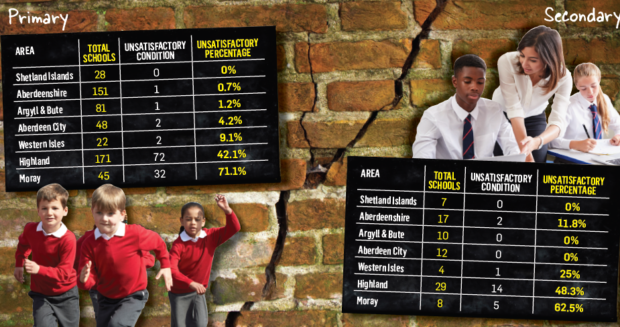More than 130 north and north-east schools suffer from “poor” building conditions and dozens are struggling with more pupils than they were built for, figures have revealed.
Highland Council had the most schools in an unsatisfactory state in Scotland with 72 primaries and 14 secondaries failing to make the grade.
Moray Council recorded the highest proportion of primary and secondary schools in an unsatisfactory or poor state.
Scottish Government figures revealed 32 out of 45 primaries in Moray were in a poor condition, the equivalent of 71%. Of the council’s eight secondary schools, five were in a poor state (62.5%)
Among the schools to fall into that category were Culloden Academy, Inverness, which had a collapsed ceiling in recent years, and Milne’s High School, Fochabers, which was saved from closure a few years ago.
Aberdeenshire had two secondary schools and one primary in a poor condition, Western Isles had three (two primaries and one secondary) and in Aberdeen City there were two primaries that fell into the unsatisfactory category.
Jamie Halcro-Johnston, Tory Highlands and Islands MSP, described the figures as “shocking”.
“Our warnings about the neglect of Moray and the north of Scotland by the SNP Scottish Government are correct. It is having a direct impact on the people we represent,” he said.
The data showed that Aberdeenshire recorded the most schools that were over 100% capacity when it came to pupil numbers with 18, followed by 14 in Highland and eight in Aberdeen City.
Four Aberdeenshire primaries recorded capacity of over 160% – the highest in Scotland. Last night, the council insisted the high figures were down to its method of measuring capacity, which did not include annexes and outbuildings.
Gillian Owen, education committee chairwoman, added that since these figures were gathered, the authority had carried out a fresh review which showed only three primary schools were over capacity – Old Rayne, Towie and Dunnottar.
Fraserburgh councillor, and former teacher, Charles Buchan said pupil numbers were rising because it was a “growth area”, adding that there was a programme of rebuilding and extensions.
He said: “The problem is Aberdeen city and Aberdeenshire are growth areas and the number of potential pupils continues to rise. We have got an increasing programme of extensions and rebuilds. The council has been aware of these pressures for a long, long time.”
A Moray spokeswoman said £142 million was needed to bring buildings up to standard, which was “unachievable” given the council’s financial position.
Councillor John Finlayson of Highland Council, said the local authority was looking to work with the Scottish Government for schools investment.
>> Keep up to date with the latest news with The P&J newsletter
Public Finance Minister and Skye Lochaber and Badenoch MSP Kate Forbes said it was “no secret” that there were schools in “desperate need of upgrading”.
She added that the government had invested billions in school buildings and said council budgets took into account building numbers, adding it was up to local authorities to bid for more cash.
